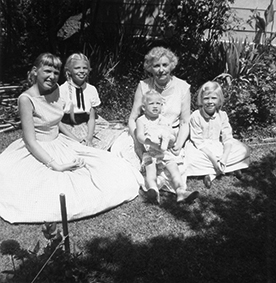Column: Gardening with kids

For my garden column today, I chose to write about a topic that is very near and dear to me. That is gardening with kids.
As I explain in my column, I was introduced to gardening as a toddler and my love of gardening has remained with me throughout my life. And who would have thought it would become my occupation as well?!
In the photo to the left, that is my wonderful grandmother with my sisters and myself (I have the place of honor in her lap!). You’ll even notice a row of zinnias in the lower left corner of the photo – hmm, maybe that’s where I got my love of zinnias?
I rarely ask anything of you, but if there’s one thing I could request, it is this:
Get kids involved in gardening! I’m talking about your own kids or grandkids, neighbor kids – you name it. Gardening is a skill that EVERYONE should have and it’s a great opportunity to create a special bond with little ones.
I hope you’ll enjoy my column.
by Susan Mulvihill
I was first introduced to gardening when I was a toddler. The garden happened to be my grandmother’s and I loved how she would take me by the hand to show me what she was growing. Her tasty boysenberries were always a big hit with me and a happy memory to this day.
My mom was a wonderful gardener as are my three sisters. Being around gardening so much at an early age had a positive impact on me and it has been an integral part of my life.
Getting kids involved in a garden is more important than ever. In addition to learning how to grow fruits and veggies, they’ll proudly eat that fresh produce and also develop an appreciation for nature. When you think about the price of groceries these days, growing your own food makes good sense – but teaching new generations of gardeners is even better.
If you’ve never grown a garden before, this is the perfect time to start because you and your kids or grandkids can learn together. If you don’t have kids in town, borrow your neighbors’ kids – with their permission, of course – and start a new tradition.
For a first garden, it’s important to keep your project relatively small so you and your garden buddies don’t get overwhelmed. An area that is about 4 feet by 8 feet would be an ideal size but if you don’t have a plot available, containers are a viable alternative provided they have drainage holes.
Choose a nice sunny spot that gets at least 6 hours of full sun per day. You’ll also want a water source close by so it’s easy to care for your plants. The goal is to keep the soil lightly moist on a consistent basis, rather than going from the extremes of bone dry to sopping wet.
In the Inland Northwest, the danger of frost should pass by the end of this month. Then it’s safe to plant tender crops such as tomatoes, beans, squash and pumpkins.
Start off with a discussion of what the group would like to grow, with everyone involved getting a vote. Be sure to include something that grows very quickly, such as radishes, so there’s a speedy reward.
Think about growing cherry tomatoes since they easily pop into the mouth. Sungold and Supersweet 100 are two of the tastiest varieties. Consider growing small pumpkins to harvest later in the season. Reliable varieties include Jack Be Little, Baby Boo and New England Pie. A sunflower-growing contest will add to the fun and attract pollinators.
Zucchinis are really easy to grow and, in addition to including them on the dinner menu, you and your fellow gardeners can team up to make a loaf of zucchini bread. A sweet treat always helps with morale, right? To instill even more pride in the harvest, see if the kids would like to enter the produce they have grown in the fair.
Throughout the season, take the time to identify insects together. Our gardens are inhabited by both beneficial and damaging insects but they’re all fascinating.
No matter how many ways the kids get involved in growing a garden, there are two important points to keep in mind. First, you will have a positive impact on them as you spend valuable time together. Second, those experiences will stay with them throughout their lives, meaning they are very likely to continue the tradition.
Susan Mulvihill is author of “The Vegetable Garden Problem Solver Handbook” and “The Vegetable Garden Pest Handbook.” She can be reached at Susan@SusansintheGarden.com. Watch this week’s video at youtube.com/susansinthegarden.

